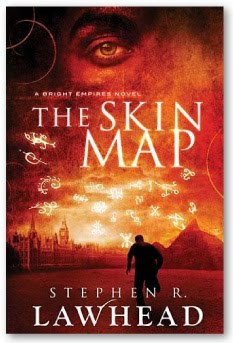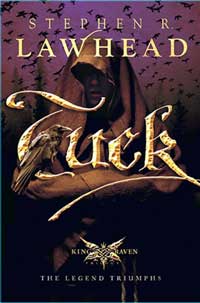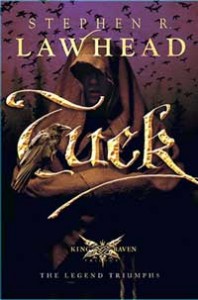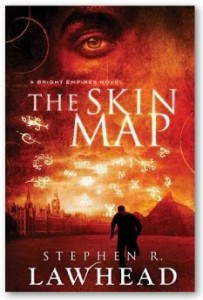by Jason Joyner | Oct 25, 2010 | Blog, christian fiction, Mike Duran, miscellaneous, Stephen Lawhead
Hey all. I haven’t gone anywhere. Busy work and trying to finish up things at home can cause blogging deficiencies though, it is a documented condition.
Instead of reading my mea culpa for being somewhat absent, you should be reading where on the scale of Christian fiction you land, if you are a writer. Thanks to Mike Duran’s post, we know have an objective scale for measuring just how Christian a particular novel is.
Actually, I’m full of it today. Mike did write an interesting post with a scale borrowed from John Wimber and his book Power Evangelism to describe where people are in their relationship (or lack thereof) with God. It was actually helpful, because it made me think about how realistic my plot progression is in my WIP. I recommend you check it out (and just follow Mike already – I link to him enough here).
In other news, I finished some light reading involving dimension-hopping and time travel. Of course I’m referring to the new novel The Skin Map by Stephen Lawhead. I’ll be discussing it more next week for a blog tour, so if the premise interests you (and it really should), then check back.
Finally, is there anything people want to discuss here? Seriously, I’m interested in some topics to help feed this fertile imagination. That way, I don’t come up with something that stinks…
OK, this post is getting far too silly. I’ll be back soon with hopefully more coherent thoughts.
—
by Jason Joyner | Oct 25, 2010 | Blog, christian fiction, Mike Duran, miscellaneous, Stephen Lawhead
Hey all. I haven’t gone anywhere. Busy work and trying to finish up things at home can cause blogging deficiencies though, it is a documented condition.
Instead of reading my mea culpa for being somewhat absent, you should be reading where on the scale of Christian fiction you land, if you are a writer. Thanks to Mike Duran’s post, we know have an objective scale for measuring just how Christian a particular novel is.
Actually, I’m full of it today. Mike did write an interesting post with a scale borrowed from John Wimber and his book Power Evangelism to describe where people are in their relationship (or lack thereof) with God. It was actually helpful, because it made me think about how realistic my plot progression is in my WIP. I recommend you check it out (and just follow Mike already – I link to him enough here).
In other news, I finished some light reading involving dimension-hopping and time travel. Of course I’m referring to the new novel The Skin Map by Stephen Lawhead. I’ll be discussing it more next week for a blog tour, so if the premise interests you (and it really should), then check back.
Finally, is there anything people want to discuss here? Seriously, I’m interested in some topics to help feed this fertile imagination. That way, I don’t come up with something that stinks…
OK, this post is getting far too silly. I’ll be back soon with hopefully more coherent thoughts.
—

by Jason Joyner | Aug 26, 2010 | Blog, Stephen Lawhead, TitleTrakk, writing craft
Stephen Lawhead is one of the best speculative fiction authors out there currently, and even though he is a Christian who writes, he has had success crossing over into the general market.
He recently did an interview with C.J. Darlington over at TitleTrakk.com (a great resource on fiction, movies, and music that I too often overlook) that had an excellent discussion on his approach to writing. Below is the extended quote, but I encourage you to check out the whole interview, buy Stephen’s new book, and bookmark TitleTrakk for frequent viewing! The highlighted areas are by me:
“CJ: You are a Christian, but you don’t necessarily write what people call “Christian fiction”. The Skin Map touches on some greater themes without the bad language and violence. Is that purposeful on your part?
SL: I write for the widest possible readership, and I always have, even at Campus Life magazine. This whole thing about earning the right to be heard is important. I always enjoyed the classic, golden age of the novel, back in the 1880’s and 1890’s. It’s amazing how many men of faith were involved in that, and yet the books they produced are not labeled Christian fiction; they just wrote books for people like themselves who liked to read. That’s what I’ve tried to do. Sometimes I would like to have a little freer hand with the language, but I know that can also be a barrier. I’ve learned that most people in books when they use off color language, that is usually a failure of imagination, if nothing else. It’s also a moral failure. It’s so easy to put a graphic word or a swear word for shock value. But when I use a word I want it to mean what it means and have the value that I put on it. There are rare times when an artist needs to even have black on his pallette. You have to draw the line somewhere, and where I choose to draw it may be over the line for some people and others sail right by it. I don’t willfully try to offend, but sometimes you reach for a word and there are only one or two that will do. In The Skin Map we use the word “bastard” a couple times in the way it is intended to be used, but I’m sure some people will not appreciate that.
A fiction story is meant to present a dream, a sort of waking dream for the reader. You want to create a world where they can enter in and participate. You try everything you can to keep that dream alive in a continuous, seamless, whole. Any jolts that wake the reader up from the dream have to go, whether it’s a clunky scene or a sentence that isn’t quite right. You try to minimize shocks that will wake up the reader that you are trying to lull into a dream. Language can do that. Sex scenes are quite overdone these days, so I try to write scenes that aren’t dependent on that. I got in trouble with that with Patrick, because he’s a 17 year old young guy whose attracted to all the young ladies. To make it true to his life as a saint who has to battle these demons there was a scene or two that was illustrative of this point. Some people don’t understand why that has to be there, especially for good ol’ Saint Patrick, but even the best saints struggle. That is part of the human condition.”
—

by Jason Joyner | Aug 26, 2010 | Blog, Stephen Lawhead, TitleTrakk, writing craft
Stephen Lawhead is one of the best speculative fiction authors out there currently, and even though he is a Christian who writes, he has had success crossing over into the general market.
He recently did an interview with C.J. Darlington over at TitleTrakk.com (a great resource on fiction, movies, and music that I too often overlook) that had an excellent discussion on his approach to writing. Below is the extended quote, but I encourage you to check out the whole interview, buy Stephen’s new book, and bookmark TitleTrakk for frequent viewing! The highlighted areas are by me:
“CJ: You are a Christian, but you don’t necessarily write what people call “Christian fiction”. The Skin Map touches on some greater themes without the bad language and violence. Is that purposeful on your part?
SL: I write for the widest possible readership, and I always have, even at Campus Life magazine. This whole thing about earning the right to be heard is important. I always enjoyed the classic, golden age of the novel, back in the 1880’s and 1890’s. It’s amazing how many men of faith were involved in that, and yet the books they produced are not labeled Christian fiction; they just wrote books for people like themselves who liked to read. That’s what I’ve tried to do. Sometimes I would like to have a little freer hand with the language, but I know that can also be a barrier. I’ve learned that most people in books when they use off color language, that is usually a failure of imagination, if nothing else. It’s also a moral failure. It’s so easy to put a graphic word or a swear word for shock value. But when I use a word I want it to mean what it means and have the value that I put on it. There are rare times when an artist needs to even have black on his pallette. You have to draw the line somewhere, and where I choose to draw it may be over the line for some people and others sail right by it. I don’t willfully try to offend, but sometimes you reach for a word and there are only one or two that will do. In The Skin Map we use the word “bastard” a couple times in the way it is intended to be used, but I’m sure some people will not appreciate that.
A fiction story is meant to present a dream, a sort of waking dream for the reader. You want to create a world where they can enter in and participate. You try everything you can to keep that dream alive in a continuous, seamless, whole. Any jolts that wake the reader up from the dream have to go, whether it’s a clunky scene or a sentence that isn’t quite right. You try to minimize shocks that will wake up the reader that you are trying to lull into a dream. Language can do that. Sex scenes are quite overdone these days, so I try to write scenes that aren’t dependent on that. I got in trouble with that with Patrick, because he’s a 17 year old young guy whose attracted to all the young ladies. To make it true to his life as a saint who has to battle these demons there was a scene or two that was illustrative of this point. Some people don’t understand why that has to be there, especially for good ol’ Saint Patrick, but even the best saints struggle. That is part of the human condition.”
—

by Jason Joyner | May 20, 2009 | Blog, reviews, speculative fiction, Stephen Lawhead, Tuck

After limping through this tour by pulling up old content of mine, I finally have something original to offer: my review of Stephen Lawhead’s latest book, Tuck.
*The final book of the King Raven trilogy picks the action up right after the ending betrayal in Scarlet. Bran and his followers, the Grellon, are returning to the wild and dark forest known as the Marsh when Norman knights ride up on them for an ambush.
After the battle, Bran attempts a peace accord with the usurping lord of his kingdom, Abbot Hugo and his marshal Guy Gysburne. The overture is grossly spurned, and Bran is determined to fight for their rightful freedom. He travels to the northern Welsh to enlist his mother’s kin to help him, while Lady Merian considers the help her own family might be able to offer.
As Bran attempts a daring rescue for a northen Welsh king, his foes bring in the armies of King William Rufus. A climatic battle looms for the woodland fugitives, whether the help is available or not…*
Tuck brings out all the things we love about the Robin Hood legend – arrows flying, daring escapes, cunning impersonations, and a friar who raps the bad guys on the head with a stout staff.
I’ve noted in my last two posts on the first books, Hood and Scarlet, that Lawhead is a great writer but somewhat streaky. Tuck falls into the pattern of the first book, with multiple third person points of view, although mainly following the jolly fat friar we all know and love. Scarlet was mainly from Will Scarlet’s point of view, differing from the other books. Changing point of view is a Lawhead trademark, and I think this sometimes is his undoing.
Thankfully, he avoids the letdown trap in Tuck. Lawhead really found an authentic voice and characterization for all of his major characters. Bran (Robin Hood), Tuck, King William, and others have distinct personalities and act believably throughout. The forest is a tangible danger for the Ffreinc knights who try to defeat the Grellon, but the overwhelming numbers provide equally real suspense whether Bran will succeed or not.
There is a good balance of action and rest in between conflict, without any real dragging parts. As the third in the series, there is a pretty good introduction to all the characters without slowing down the plot. I read the first two long enough ago I couldn’t remember all the events that are mentioned, so that was my only complaint in this area.
Overall Tuck is a highly enjoyable and satisfying finish to a very strong series. I think Scarlet was the best book of the series, but Lawhead did a very good job of making each book stand up on its own.
If you’re a fan of historical fiction, alternate stories, or speculative fiction, then this series is for you. There is enough Celtic lore to make it speculative, even though it mostly rests in the historical realm. However, any fan of Christian speculative fiction would do well to read liberally from Lawhead’s collection of books.
—

by Jason Joyner | May 20, 2009 | Blog, reviews, speculative fiction, Stephen Lawhead, Tuck

After limping through this tour by pulling up old content of mine, I finally have something original to offer: my review of Stephen Lawhead’s latest book, Tuck.
*The final book of the King Raven trilogy picks the action up right after the ending betrayal in Scarlet. Bran and his followers, the Grellon, are returning to the wild and dark forest known as the Marsh when Norman knights ride up on them for an ambush.
After the battle, Bran attempts a peace accord with the usurping lord of his kingdom, Abbot Hugo and his marshal Guy Gysburne. The overture is grossly spurned, and Bran is determined to fight for their rightful freedom. He travels to the northern Welsh to enlist his mother’s kin to help him, while Lady Merian considers the help her own family might be able to offer.
As Bran attempts a daring rescue for a northen Welsh king, his foes bring in the armies of King William Rufus. A climatic battle looms for the woodland fugitives, whether the help is available or not…*
Tuck brings out all the things we love about the Robin Hood legend – arrows flying, daring escapes, cunning impersonations, and a friar who raps the bad guys on the head with a stout staff.
I’ve noted in my last two posts on the first books, Hood and Scarlet, that Lawhead is a great writer but somewhat streaky. Tuck falls into the pattern of the first book, with multiple third person points of view, although mainly following the jolly fat friar we all know and love. Scarlet was mainly from Will Scarlet’s point of view, differing from the other books. Changing point of view is a Lawhead trademark, and I think this sometimes is his undoing.
Thankfully, he avoids the letdown trap in Tuck. Lawhead really found an authentic voice and characterization for all of his major characters. Bran (Robin Hood), Tuck, King William, and others have distinct personalities and act believably throughout. The forest is a tangible danger for the Ffreinc knights who try to defeat the Grellon, but the overwhelming numbers provide equally real suspense whether Bran will succeed or not.
There is a good balance of action and rest in between conflict, without any real dragging parts. As the third in the series, there is a pretty good introduction to all the characters without slowing down the plot. I read the first two long enough ago I couldn’t remember all the events that are mentioned, so that was my only complaint in this area.
Overall Tuck is a highly enjoyable and satisfying finish to a very strong series. I think Scarlet was the best book of the series, but Lawhead did a very good job of making each book stand up on its own.
If you’re a fan of historical fiction, alternate stories, or speculative fiction, then this series is for you. There is enough Celtic lore to make it speculative, even though it mostly rests in the historical realm. However, any fan of Christian speculative fiction would do well to read liberally from Lawhead’s collection of books.
—



